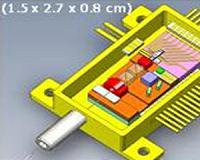 |
Washington DC (SPX) Apr 05, 2011 Many of today's conflicts occur in urban settings, making the ability to visualize conditions in urban areas increasingly important to commanders and mission planners. The Defense Advanced Research Projects Agency (DARPA) recently completed a five-year program called Urban Photonic Sandtable Display (UPSD) that creates a real-time, color, 360-degree 3D holographic display to assist battle planners. Without having to wear 3D goggles or glasses, a team of planners can view a large-format, interactive 3D display. Until now, two-dimensional, high-resolution flat panel color displays and 3D static monochrome images have been the most advanced visual planning tools available. UPSD assists team-based mission planning, visualization and interpretation of complex 3D data such as intelligence and medical imagery. It permits simultaneous viewing for up to 20 participants and is interactive, allowing the image to be frozen, rotated and zoomed up to the resolution limit of the data. The holographic display enables full visual depth capability up to 12 inches. The technology also enables realistic two-dimensional printouts of the 3D imagery that front line troops can take with them on missions. UPSD is based on full-parallax technology, which enables each 3D holographic object to project the correct amount of light that the original object possessed in each direction, for full 360- degree viewing. Current 3D displays lack full-parallax and only provide 3D viewing from certain angles with typically only three to four inches of visual depth. Presently UPSD is a scalable display platform that can be expanded from a six-inch diagonal size up to a six-foot diagonal, in both monochrome and color formats. UPSD is part of DARPA's broader efforts in 3D technology research. DARPA recently demonstrated a wide-area 3D LIDAR (Light Detection and Ranging) mapping capability under DARPA's High Altitude LIDAR Operations Experiment (HALOE). HALOE is providing forces in Afghanistan with unprecedented access to high-resolution 3D data, collected at rates orders of magnitude faster and from much longer ranges than conventional methods. UPSD's 3D display can support the rapid exploitation of this data for detailed mission planning in rugged, mountainous and complex urban terrain. DARPA is initially transitioning the UPSD technology to an Air Force research center and two Army research centers to apply the technology to critical applications where the 3D holographic display will provide a unique benefit. Zebra Imaging of Austin, Texas, was awarded the initial contract in 2005 and has researched and developed the technology.
Share This Article With Planet Earth
Related Links Defense Advanced Research Projects Agency The latest in Military Technology for the 21st century at SpaceWar.com
 NEW-HIP Program Advances Avionics Networks
NEW-HIP Program Advances Avionics NetworksWashington DC (SPX) Apr 05, 2011 Modern military aircraft are burdened with miles of heavily shielded copper wire cables that connect a multitude of components. This cabling is heavy and subject to deterioration due to harsh environmental conditions encountered in normal flight operations. In addition, cables needed for carrying analog radio frequency signals are expensive, fragile and difficult to install and replace. So ... read more |
|
| The content herein, unless otherwise known to be public domain, are Copyright 1995-2010 - SpaceDaily. AFP and UPI Wire Stories are copyright Agence France-Presse and United Press International. ESA Portal Reports are copyright European Space Agency. All NASA sourced material is public domain. Additional copyrights may apply in whole or part to other bona fide parties. Advertising does not imply endorsement,agreement or approval of any opinions, statements or information provided by SpaceDaily on any Web page published or hosted by SpaceDaily. Privacy Statement |